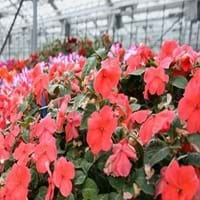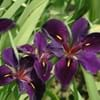Life Span
Perennial
Perennial
Type
Tender Perennial
Bulb or Corm or Tuber
Origin
Eastern Africa
South America, Argentina
Types
Impatients balsamina, Impatients hawkeri, Impatiens nolitangere
Not Available
Number of Varieties
Not Available
Habitat
Damp Places, Damp shady woods, Forest margins, Roadsides, tropical environments, Waste areas, waterways
Temperate Regions
USDA Hardiness Zone
10-15
5-9
Sunset Zone
A2, A3, 1a, 1b, 2a, 2b, 3a, 3b, 4, 5, 6, 7, 8, 9, 14, 15, 16, 17, 18, 19, 20, 21, 22, 23, 24
21,22
Habit
Oval or Rounded
Clump-Forming
Flower Color
White, Red, Purple, Pink, Magenta, Rose, Salmon, Coral, Peach, Burgundy
Light Blue, Light Purple, Silver, Sky Blue
Flower Color Modifier
Bicolor
Bicolor
Fruit Color
Green
Not Available
Leaf Color in Spring
Green, Dark Green, Burgundy, Crimson, Bronze
Green, Light Green, Gray Green
Leaf Color in Summer
Green, Dark Green, Burgundy, Crimson, Bronze
Light Green
Leaf Color in Fall
Green, Dark Green, Burgundy, Crimson
Several shades of Green
Leaf Color in Winter
Light Green
Light Green
Leaf Shape
Oblong elliptic
Grass like
Plant Season
Spring, Summer, Fall, Winter
Spring
Sunlight
Partial Sun, Partial shade, Full Shade
Full Sun, Partial Sun, Partial shade
Growth Rate
Very Fast
Medium
Type of Soil
Loam, Sand
Clay, Loam, Sand
The pH of Soil
Acidic, Neutral
Acidic, Neutral, Alkaline
Soil Drainage
Well drained
Well drained
Bloom Time
Spring, Late Spring, Early Summer, Summer, Late Summer, Early Fall, Fall
Early Spring, Spring, Late Winter
Tolerances
Shade areas
Drought
Where to Plant?
Container, Ground, Pot
Container, Ground
How to Plant?
Seedlings, Softwood cuttings, Stem Cutting
By dividing rhizomes, tubers
Plant Maintenance
Medium
Medium
Watering Requirements
Do not let dry out between waterings, Requires consistently moist soil
Average Water Needs, Do Not over Water, Requires regular watering
In Summer
Lots of watering
Lots of watering
In Spring
Moderate
Moderate
In Winter
Average Water
Average Water
Soil pH
Neutral, Alkaline
Acidic, Neutral, Alkaline
Soil Type
Loam, Sand
Clay, Loam, Sand
Soil Drainage Capacity
Well drained
Well drained
Sun Exposure
Partial Sun, Partial shade, Full Shade
Full Sun, Partial Sun, Partial shade
Pruning
Cut away fading foliage, Cut or pinch the stems, Remove branches that rub together, Remove damaged leaves, Remove dead branches, Remove dead flowers, Remove dead leaves, Remove dead or diseased plant parts, Remove deadheads, Remove the old foliage
Remove damaged leaves, Remove dead branches, Remove dead leaves
Fertilizers
Apply N-P-K
All-Purpose Liquid Fertilizer
Pests and Diseases
Aphids, Downy mildew, Stem rot
Slugs, Snails
Plant Tolerance
Shade areas
Drought
Flower Petal Number
Single, Double
Single
Foliage Texture
Medium
Medium
Foliage Sheen
Matte
Matte
Attracts
Butterflies, Hummingbirds, Not Available
Bees, Birds, Hummingbirds
Allergy
Not Available
Not Available
Aesthetic Uses
Beautification, Cottage Garden, Hanging Basket, Showy Purposes
Showy Purposes
Beauty Benefits
Not Available
Not Available
Environmental Uses
Air purification
Air purification
Medicinal Uses
Demulcent, Gastrointestinal disorders, Nutritive, Skin irritation
No Medicinal Use
Part of Plant Used
Flowers, Root
Flowers
Other Uses
Basketary, Showy Purposes, Used as Ornamental plant, Used for bedding in gardens
Not Available
Used As Indoor Plant
Yes
Yes
Used As Outdoor Plant
Yes
Yes
Garden Design
Bedding Plant, Container, Edging, Hanging Basket, Mixed Border, Tropical
Container, Lawns and Turf, Mixed Border, Rock Garden / Wall, Wildflower
Botanical Name
IMPATIENS walleriana
Ipheion uniflorum
Common Name
Busy Lizzy, Impatiens, balsam, sultana
Spring Starflower, Springstar
In Hindi
wallenana
Spring Starflower
In German
wallenana
Frühling Borretsch
In French
wallenana
Spring Starflower
In Spanish
wallenana
primavera Flor de estrella
In Greek
Απασχολημένος Lizzy Φυτών
άνοιξη starflower
In Portuguese
wallenana
primavera Starflower
In Polish
wallenana
Wiosna Starflower
In Latin
Impatiens Walleriana
Spring Starflower
Phylum
Magnoliophyta
Magnoliophyta
Class
Magnoliopsida
Lilopsida
Order
Geraniales
Asparagales
Family
Balsaminaceae
Liliaceae
Clade
Angiosperms, Asterids, Eudicots
Angiosperms, Monocots
Tribe
Not Available
Gilliesieae
Subfamily
Not Available
Allioideae
Number of Species
Not Available
Importance of Busy Lizzy and Spring Starflower
Want to have the most appropriate plant for your garden? You might want to know the importance of Busy Lizzy and Spring Starflower. Basically, these two plants vary in many aspects. Compare Busy Lizzy and Spring Starflower as they differ in many characteristics such as their life, care, benefits, facts, etc. Every gardener must at least have the slightest clue about the plants he wants to plant in his garden. Compare their benefits, which differ in many ways like facts and uses. The medicinal use of Busy Lizzy is Demulcent, Gastrointestinal disorders, Nutritive and Skin irritation whereas of Spring Starflower is No Medicinal Use. Busy Lizzy has beauty benefits as follows: Not Available while Spring Starflower has beauty benefits as follows: Not Available.
Compare Facts of Busy Lizzy vs Spring Starflower
How to choose the best garden plant for your garden depending upon its facts? Here garden plant comparison will help you to solve this query. Compare the facts of Busy Lizzy vs Spring Starflower and know which one to choose. As garden plants have benefits and other uses, allergy is also a major drawback of plants for some people. Allergic reactions of Busy Lizzy are Not Available whereas of Spring Starflower have Not Available respectively. Having a fruit bearing plant in your garden can be a plus point of your garden. Busy Lizzy has no showy fruits and Spring Starflower has no showy fruits. Also Busy Lizzy is flowering and Spring Starflower is not flowering . You can compare Busy Lizzy and Spring Starflower facts and facts of other plants too.





